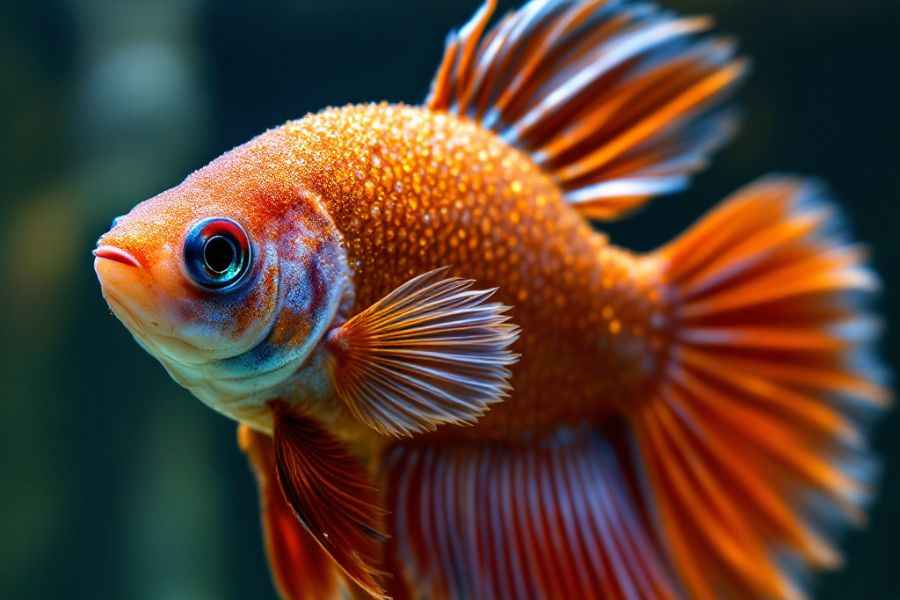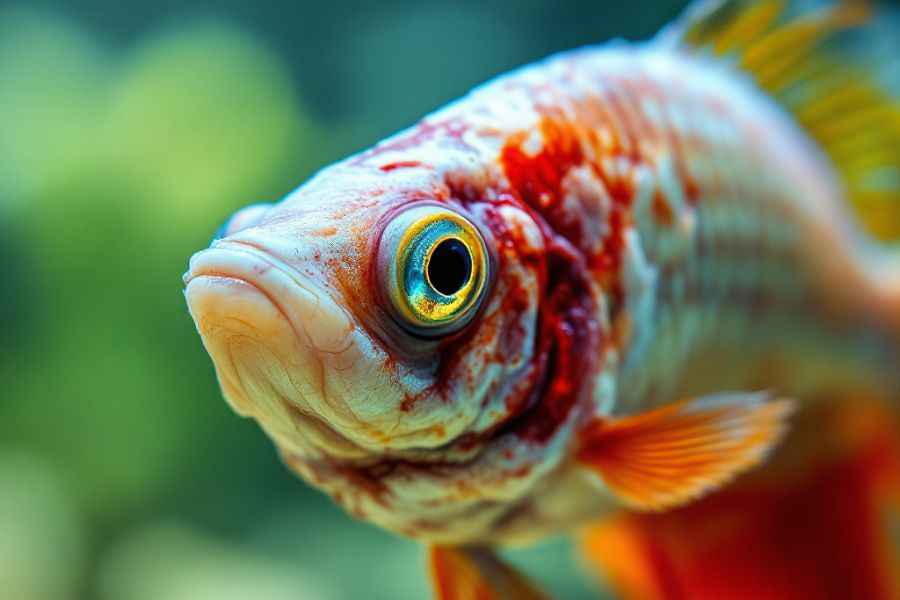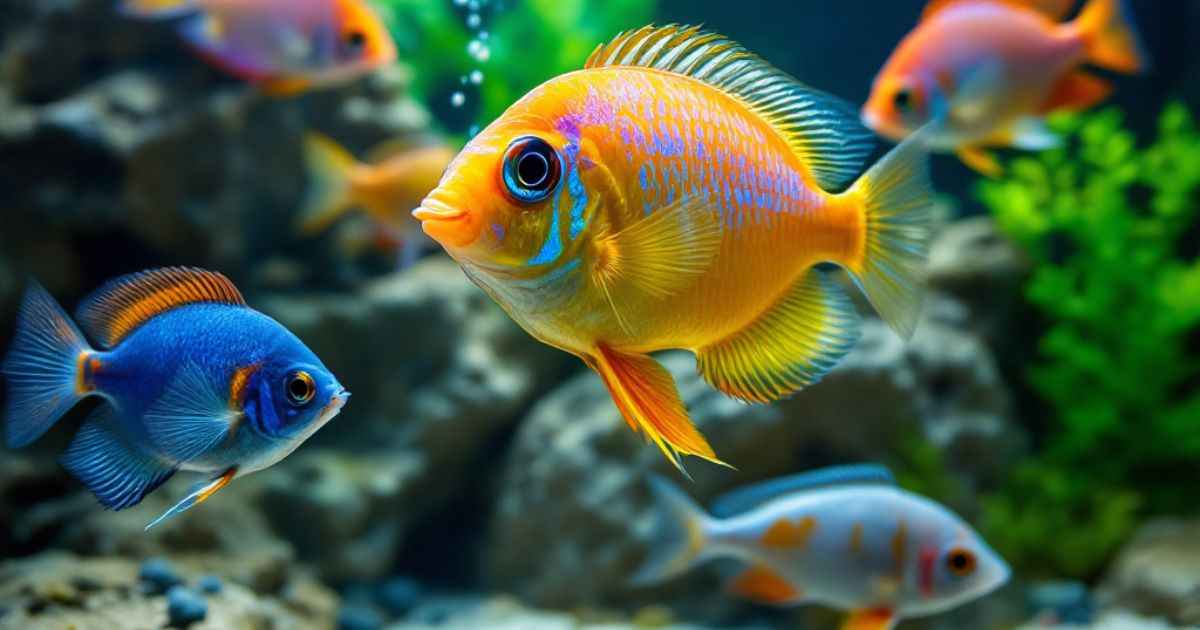Betta fish, with their vibrant colors and flowing fins, are among the most popular freshwater fish kept by aquarium enthusiasts. But caring for a Betta isn’t just about admiring their beauty—it requires knowledge of their health needs and an understanding of the diseases they’re prone to. Like all living creatures, Betta fish can suffer from various illnesses, and if left untreated, these can lead to severe health problems or even death.
In this comprehensive guide, we’ll explore the most common Betta fish diseases, their symptoms, causes, and treatments. Additionally, we’ll discuss practical tips for preventing these illnesses and maintaining a thriving aquarium. Whether you’re a seasoned Betta owner or new to fishkeeping, this article is your go-to resource for keeping your Betta fish happy and healthy.
Why Understanding Betta Fish Diseases Is Crucial
Caring for a Betta fish isn’t just about feeding them and keeping their tank clean; it’s about creating an environment where they can thrive. Poor water quality, inadequate tank setups, and stress are the biggest contributors to the disease in Betta fish. Early detection of illness is key because the sooner you act, the better the chances of recovery.
For instance, diseases like fin rot, Ich (white spot disease), and Velvet can escalate quickly if not treated promptly. By recognizing the symptoms and understanding the root causes, you can save your Betta from unnecessary suffering. Moreover, prevention is always better than cure—maintaining a clean tank, feeding a balanced diet, and reducing stress can go a long way in keeping your Betta healthy.
Common Betta Fish Diseases
Betta fish are stunning and resilient little swimmers, but even the healthiest Betta can fall ill from time to time. Most of their diseases stem from poor water conditions, stress, or even a weakened immune system. If you’ve noticed your Betta acting differently or looking unwell, there’s a good chance it’s battling one of the common health problems we’ll discuss below.
| Disease | Symptoms | Cause | Treatment |
|---|---|---|---|
| Dropsy | Swollen body, pinecone-like scales, lethargy, loss of appetite | Bacterial infection, kidney failure, and poor water quality | Isolate in a quarantine tank, treat with antibiotics like Kanamycin, and use Epsom salt baths. |
| Swim Bladder Disease | Difficulty swimming, floating sideways, sinking to the bottom | Overfeeding, constipation, or physical injury | Fast for 24-48 hours, feed deshelled, boiled peas, maintain clean water, and a stable temperature. |
| Popeye | Swollen or bulging eyes, cloudiness, lethargy | Bacterial infection, physical injury, and poor water quality | Isolate, treat with antibiotics like Erythromycin, and add aquarium salt to reduce swelling. |
| Velvet Disease | Gold or rust-colored dust on the body, clamped fins, lethargy, flashing | Parasitic protozoa, poor water conditions | Treat with copper-based medications, dim tank lights, raise water temperature slightly. |
| Columnaris | Cotton-like patches, frayed fins, ulcers, lethargy | Bacterial infection, warm and unclean water | Isolate fish, treat with Kanamycin or Furan-2, add aquarium salt to reduce stress. |
| Ich (White Spot Disease) | White spots on the body and fins, rubbing against objects, lethargy | Parasitic infection, poor water quality | Raise temperature to 82-86°F, treat with Malachite Green or Formalin, maintain clean water. |
| Fungal Infections | White, cottony growths on body or fins | Injuries, poor water quality | Treat with Methylene Blue or antifungal meds, use salt baths, keep water clean. |
| Hole in the Head | Small pits or holes on the head, lethargy | Poor nutrition, stress, inadequate water quality | Improve diet, treat with Metronidazole if severe, maintain clean water. |
| Constipation | Swollen abdomen, difficulty swimming | Overfeeding, lack of fiber in diet | Fast for 1-2 days, feed deshelled, boiled peas, avoid overfeeding. |
| Anchor Worms | Visible worm-like protrusions, redness, irritation | Parasitic infection | Remove worms manually with tweezers, treat tank with Dimilin, quarantine new fish. |
| Betta Tumors | Visible lumps or growths on body | Genetic predisposition, environmental stressors | No guaranteed treatment, monitor for discomfort, maintain stress-free tank conditions. |
| White Spot Disease | Small white spots on body and fins, flashing, lethargy | Parasites (same as Ich) | Same as Ich: Raise temperature, treat with anti-parasitic medications, quarantine new fish. |
| Tuberculosis | Weight loss, curved spine, lethargy | Mycobacterium bacteria | No reliable treatment, euthanasia may be necessary, maintain clean water to prevent outbreaks. |
| Bacterial Infections | Red streaks, ulcers, clamped fins, lethargy | Poor water quality, injuries, stress | Treat with Maracyn, Furan-2, or similar antibiotics, add aquarium salt to reduce stress. |
| Septicemia | Red streaks on body, lethargy, loss of appetite | Bacterial infection spreading through the bloodstream | Isolate fish, treat with antibiotics like Kanamycin, improve water quality. |
| Fish Lice | Visible lice on body, irritation, erratic swimming | Parasitic infection | Manually remove lice, treat with anti-parasitic medications, quarantine new fish. |
| Furunculosis | Boil-like sores on body, lethargy, loss of appetite | Bacterial infection | Treat with Furan-2, maintain clean water, reduce tank stressors. |
| Gill Flukes | Gasping for air, inflamed gills, rubbing against objects | Parasitic worms | Treat with Praziquantel, improve water quality, quarantine new fish. |
| Betta Fin Rot | Frayed or discolored fins, fin tissue deteriorating | Bacterial or fungal infection, poor water quality | Use antibiotics for bacterial fin rot, antifungal meds for fungal cases, maintain clean water. |
| Poisoning | Erratic swimming, gasping for air, lethargy | Ammonia, nitrites, chlorine, or other toxins | Move fish to clean, dechlorinated water immediately, resolve toxin source, use water conditioner. |
Betta Disease Pictures and Synopsis
1. Dropsy

If your Betta looks bloated or swollen, and their scales stick out like a pinecone, they might have Dropsy. It’s not a disease but rather a symptom of serious internal issues, often caused by bacterial infections or kidney failure. You’ll probably also notice lethargy and lack of appetite.
The root cause is almost always poor water quality or a weakened immune system. Unfortunately, Dropsy is tough to treat, but isolating your fish in a quarantine tank and using antibiotics like Kanamycin can help. Epsom salt baths can also reduce swelling. Prevention is your best bet—keep their water clean and feed them a healthy, varied diet.
2. Swim Bladder Disease

Does your Betta look like it’s stuck floating sideways or struggling to stay upright? That’s likely Swim Bladder Disease, and it’s pretty common. Overfeeding, constipation, or even an injury can cause this condition.
Here’s the good news—it’s usually treatable! Fast your Betta for 24-48 hours and then feed them a tiny piece of deshelled, boiled pea. This helps clear up constipation, which is often the culprit. Keep the water clean and ensure the temperature stays stable (around 78-80°F). Feeding smaller portions can prevent this from happening again.
3. Popeye

Popeye is exactly what it sounds like—your Betta’s eye (or eyes) becomes swollen or bulges out. You might also notice cloudy eyes. It could be caused by a bacterial infection, an injury, or poor water quality.
Treatment involves isolating your Betta in a separate tank and treating it with antibiotics like Erythromycin. Adding aquarium salt can also reduce swelling. To prevent Popeye, make sure your tank is clean and free of sharp decorations that can injure your fish.
4. Velvet Disease

Velvet Disease, also called “gold dust disease,” is caused by parasites that give your Betta’s body a gold or rust-colored sheen. Other symptoms include clamped fins, lethargy, and rubbing against objects in the tank (also known as flashing).
To treat Velvet, dim the tank lights, raise the water temperature slightly, and use a copper-based anti-parasitic medication. Make sure to quarantine any new fish before introducing them to your tank. Clean water is your best defense against Velvet.
5. Columnaris

Columnaris is a bacterial infection that can cause white, cotton-like patches on your Betta’s body, frayed fins, and ulcers. It’s highly contagious and thrives in warm, unclean water.
If your Betta contracts Columnaris, isolate them immediately and treat the water with antibiotics like Kanamycin. Adding aquarium salt can also help reduce stress and prevent secondary infections. To keep Columnaris at bay, maintain proper water parameters and avoid overcrowding your tank.
6. Ich (White Spot Disease)

Ich is one of the most common parasitic infections in Betta fish. It causes small white spots to appear on the body and fins, and your Betta might start rubbing against tank decorations or plants to relieve the itch.
Raise the water temperature to 82-86°F and treat the tank with anti-parasitic medications like Malachite Green. Always quarantine new fish to prevent Ich from spreading.
7. Fungal Infections (Fish Fungus)

Fungal infections often show up as white, cottony growths on your Betta’s fins or body. They usually occur after an injury or when water conditions are less than ideal.
Treat fungal infections with antifungal medications like Methylene Blue or aquarium salt baths. Prevention is simple—keep your tank clean and avoid sharp decorations that can harm your fish.
8. Hole in the Head

If you notice small pits or holes forming on your Betta’s head, it could be suffering from Hole in the Head disease. This condition is often linked to poor nutrition, stress, or inadequate water quality.
Improve your Betta’s diet by adding high-quality, protein-rich foods, and keep the water clean. Medicated food or treatments like Metronidazole can help in severe cases.
9. Constipation

A constipated Betta will often have a swollen abdomen and trouble swimming. Overfeeding or a lack of fiber in their diet is usually to blame.
The solution? Fast your Betta for a day or two and then feed them a small amount of deshelled, boiled pea. Feed them a varied diet moving forward to prevent constipation.
10. Anchor Worms

Anchor worms are parasitic worms that can attach to your Betta’s body, causing visible protrusions, redness, and irritation.
If you see anchor worms, you can manually remove them with tweezers (carefully!) and treat the tank with an anti-parasitic medication like Dimilin. Quarantine new fish to prevent bringing parasites into your tank.
11. Betta Tumors

Betta tumors appear as visible lumps or growths on their body. These can be benign or malignant, and the causes range from genetics to environmental factors.
Unfortunately, there’s no guaranteed treatment for tumors. Monitor your Betta for signs of discomfort and ensure their tank environment is as stress-free as possible.
12. Tuberculosis

Tuberculosis is a bacterial infection that can cause weight loss, a curved spine, and lethargy in Betta fish. Sadly, this disease is often fatal.
There’s no effective treatment for Betta tuberculosis, so prevention is crucial. Keep the tank clean, and avoid stressors that weaken your Betta’s immune system.
13. Bacterial Infections

Bacterial infections in Bettas can appear as red streaks, ulcers, or clamped fins. Poor water quality and injuries are common culprits.
Treat with antibiotics like Maracyn or Furan-2, and add aquarium salt to reduce stress. Regular tank maintenance is the best way to prevent these infections.
14. Septicemia

Septicemia is a bacterial infection that spreads through your Betta’s bloodstream. Symptoms include red streaks on the body, lethargy, and loss of appetite.
Isolate the fish and treat it with antibiotics like Kanamycin. Pristine water conditions are the best prevention.
15. Fish Lice

Fish lice are visible parasites that attach to your Betta’s body, causing irritation, redness, and erratic swimming.
Manually remove the lice and treat the tank with anti-parasitic medication. Quarantining new fish is essential to avoid introducing lice to your tank.
16. Furunculosis

Furunculosis is a bacterial infection that causes boil-like sores on the Betta’s body. It’s often caused by poor water conditions.
Treat with antibiotics like Furan-2 and maintain a clean, stress-free environment to prevent recurrence.
17. Gill Flukes

Gill flukes are tiny parasitic worms that attach to the Betta’s gills, causing difficulty breathing, inflamed gills, and gasping for air.
Treat with anti-parasitic medications like Praziquantel. Quarantine new fish and maintain clean water to prevent an outbreak.
18. Betta Fin Rot

Fin rot is one of the most common Betta diseases, causing the fins to fray, discolor, or rot away completely. It’s often caused by bacteria or fungi in poor water conditions.
Treat with antibiotics (if bacterial) or antifungal medications (if fungal). Regular water changes and avoiding sharp tank decorations can prevent fin rot.
19. Poisoning
Poisoning occurs when a Betta is exposed to harmful substances like ammonia, nitrites, or chlorine. Symptoms include erratic swimming, gasping for air, or lethargy.
Immediately move the fish to clean, dechlorinated water and fix the source of the toxin. Regular water testing and using a water conditioner can prevent poisoning.
Preventing Betta Fish Diseases
Preventing diseases in Betta fish is honestly easier than treating them. A little extra attention to their care goes a long way in keeping them happy and healthy. First, let’s talk about their tank.
Bettas may be small, but they thrive in tanks that are at least 5 gallons. Forget about those tiny bowls—they’re bad news for your Betta’s health. A larger tank not only gives them room to swim but also makes it easier to maintain good water quality.
Add a gentle filter to keep the water clean without creating a strong current, and make sure you’re using a heater to keep the temperature stable between 78-80°F.
Bettas are tropical fish, after all, and sudden temperature changes can stress them out and make them sick. Oh, and don’t forget to include hiding spots like soft plants or caves—your Betta will appreciate having a cozy place to relax.
Water quality is everything when it comes to preventing diseases like dropsy, Ich, or fin rot. Even if the tank looks clean, harmful toxins like ammonia or nitrites can build up quickly, especially in smaller tanks. This is why weekly water changes are a must—replace about 25-50% of the water to keep it fresh and toxin-free.
And don’t just dump in tap water! Always use a water conditioner to remove chlorine and other harmful chemicals.
If you’re adding a new fish to your tank, quarantine them first in a separate setup for at least 2-4 weeks. This small step can prevent parasites, bacteria, or fungal infections from wreaking havoc in your Betta’s home.
Finally, let’s talk about stress, because a stressed Betta is more likely to get sick. Avoid keeping them with aggressive tankmates or fin-nippers, and make sure they’re not in a noisy or high-traffic area.
Stress can also come from overfeeding, so stick to small portions of high-quality Betta pellets and occasionally treat them to live or frozen foods like bloodworms or brine shrimp. Just don’t overdo it—uneaten food can quickly pollute the tank and lead to diseases like swim bladder disease or constipation.
By creating a stable, clean, and relaxing environment, you’ll not only prevent diseases but also help your Betta live their best (and most colorful) life.
Must Read:
- 20 Best Tropical Fish for Aquarium
- How to Clean a Fish Tank: Step-by-Step Guide
- What Do Axolotls Eat? Best Diet Guide
- How Much Are Axolotls? A Complete Guide
FAQs
What are the first signs of a sick Betta fish?
If your Betta fish is sick, the first signs you’ll likely notice include lethargy (they might just sit at the bottom or surface), loss of appetite, or faded colors. Other common signs are clamped fins (their fins appear stuck to their body), abnormal swimming, or rubbing against tank decorations. Always trust your gut—if something seems “off,” it probably is. Early detection is key!
How do I prevent Betta fin rot?
Preventing fin rot is all about keeping the tank clean and stress-free. Make sure you’re doing weekly water changes, using a filter, and avoiding overcrowding. Also, check for sharp decorations that might tear their delicate fins. Feeding your Betta a nutritious, protein-rich diet is another way to keep their immune system strong and resistant to infections.
What is the best treatment for Ich?
Treating Ich, or white spot disease, involves raising the tank temperature to 82-86°F (do this gradually!) and using a reliable anti-parasitic medication like Malachite Green or Formalin. It’s also important to keep the tank clean—do regular water changes during treatment. If you have other fish in the tank, treat them too, since Ich spreads quickly.
Can Betta fish recover from fin rot?
Yes! Fin rot is very treatable, especially in its early stages. Use antibiotics (if bacterial) or antifungal medications (if fungal), and improve water quality with frequent water changes. Removing sharp decorations can also prevent further damage to their fins.
How do I quarantine a sick Betta?
Set up a small quarantine tank with a heater, filter, and clean, conditioned water. Isolate the sick Betta and monitor their behavior and symptoms. Use medications if needed, and keep the water parameters stable. A quarantine tank is essential to prevent the spread of disease to healthy fish.
Can I use salt to treat Betta diseases?
Yes, aquarium salt can be helpful for treating certain illnesses like fin rot, mild bacterial infections, or external parasites. Use it cautiously—dissolve 1 teaspoon per gallon of water and monitor your Betta closely during treatment. However, avoid overuse as it can harm plants or sensitive tankmates.
Conclusion
Caring for a Betta fish is incredibly rewarding, but it requires attention to their health and environment. By understanding the common diseases that can affect your Betta, recognizing the symptoms early, and taking preventive measures like maintaining clean water, providing a stress-free tank, and offering a balanced diet, you can ensure your Betta fish thrives. Prevention is always better than a cure, but even if your Betta gets sick, prompt action and proper treatment can make all the difference. With the right care, your Betta fish can live a long, colorful, and vibrant life, bringing joy to your aquarium every day!




